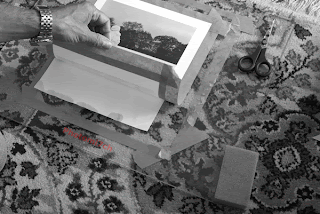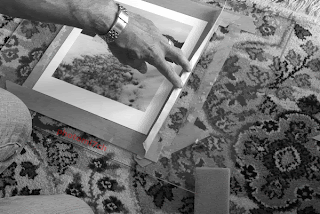This must
be one of the most frustrating things about fiber base paper. It
comes out of the wash tank like a limp rag and when it is drying it
curls up like corrugated plastic but there is no getting away from
the fact that photographs on fiber base paper have that something
extra and it is worth the trouble in making sure they are flat.
Over the years I
have used the cartridge paper and heavy books route to keeping my
prints flat. I could use a special machine that dry's the prints
using heat but I prefer the slower air dried method.
It wasn't until
Dave Miller the founder of the
film and darkroom users forum posted an article on his
method for ensuring they dry flat, that life with FB paper has
become so much easier. A big thank you to Dave for that article,
without it I would still be using heavy books and would not be
writing this post with my own refinement to his excellent method. My
adaptation allows you to print right up to the edge with out
trimming.
Equipment
needed:
- Adhesive brown paper tap that is made sticky by water. Available from most art suppliers.
- Craft knife.
- Scissors.
- Metal rule/ straight edge.
- Cartridge/ blotting paper.
- Sponge.
- Print squeege or leather.
My
adaptation:
First of all you
will need to remove any excess water from the print by hanging it for
a short while and/or use a leather to dab it away.
- Place on the glass.
- Then place the photograph picture side down on the blotting paper.
- Cut to length a strip of gummed brown adhesive tap.
- Pull the tape tight and stick half the width on to the back of the print and smooth out. Remember that the print will still be damp so the tape will not need to be wetted.
- Do the same for the other three sides. Once done turn the print over so it is picture side up.
- Pull the tape tight and stick to the tape at the top of the print half on and half off.
- Wipe the damp sponge across the glass (again do not make wet as the tape will slide across the glass) and stick down.
- Lift the print and place the blotting paper under the print and smooth down.
- Next cut another length of tape for the bottom and do as before but once the tape is stuck to the tape and the glass is damp pull the print tight and stick down. This slight tension will keep the print flat.
- Do the same for the sides.
- To remove the prints once they are dry place a metal rule/straight edge along the side of the print and cut along all the sides with a craft knife. This will release the print perfectly flat.
Notes:
 |
| Used craft knife to free picture from glass |
To remove the
tape from the glass it can be re-wetted and scraped off or place the
glass in a dish of water to soak for about five to ten minutes.It
will lift off with ease.



